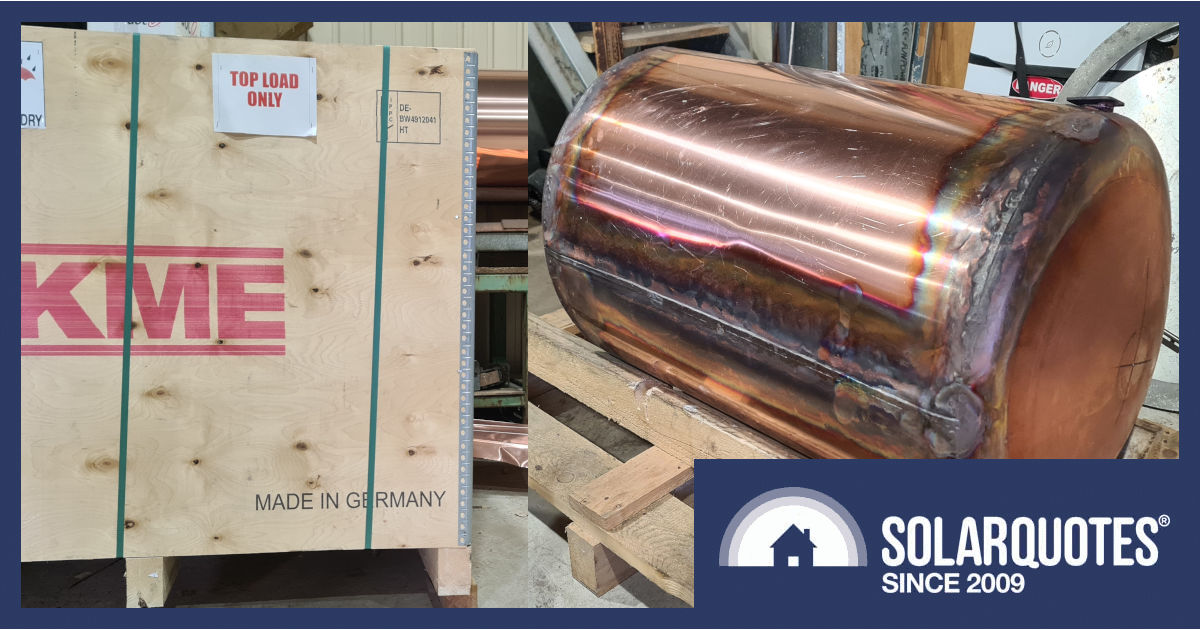
Finally, something that’s genuinely German in the solar industry… sheet copper is no longer made in Australia, sadly.
If we’ve noticed anything of late in the SolarQuotes office, it’s that water heating isn’t just a mundane task; it’s a subject passionately debated and deeply entrenched. Who would have thought?
With all the talk of woke water heaters and the virtue signalling of efficiency, it seems even the most mundane things can be polarised these days. So, it’s not without personal irony I have to mount the case for traditional conservative values—namely, an old-fashioned hot water service made from solid copper.
Durability: It’s The Last Word
Our first hot water service on the farm was installed before mains electricity arrived in 1959 and lasted well into the next century. It outlived the original purchaser. So when I want a hot water service that’s the best thing bar none, I invariably get an all-copper tank, usually custom built by Bill from Gramall, who’s been making them since 1976. He doesn’t have much of a web presence, but his number is 0412 168 184.
A Short History Lesson
Even before there was plumbing, hot water was always tied to the stove in your house, and sometimes still is. However, the Australian climate made having a stove-hot kitchen miserable. Many used a donkey: a tank outside under which you set a fire, and they’re still used in some places.
Some had “chip heaters” that burned kindling or pine cones; when instantaneous hot water meant a bath 20 minutes after you lit the fire. And there were wood, coke and oil-fired kitchen stoves with plumbing for a water jacket. These would be connected to a tank outside the kitchen, or in the roof space.
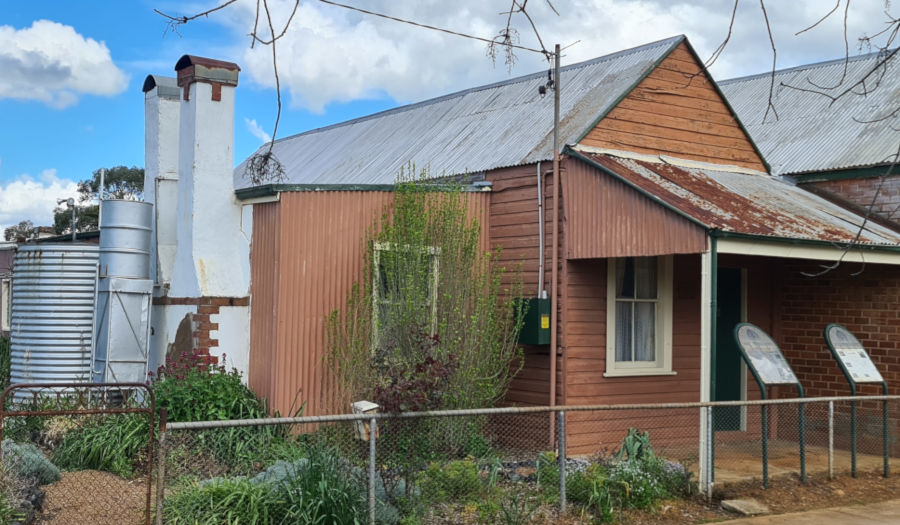
This heritage-listed house in Yeoval, NSW has an original hot water service. Round 44-gallon drum to provide modest pressure, sitting on top of an insulated tank plumbed through the back of the chimney into the kitchen stove.
What Does It Have To Do With Solar Hot Water?
With a tank in the roof storing water you heated with the stove, it wasn’t too much of a leap to put some pipes outside the roof, under a piece of glass, and get the sun to heat the water instead, and so solar thermal hot water was born.
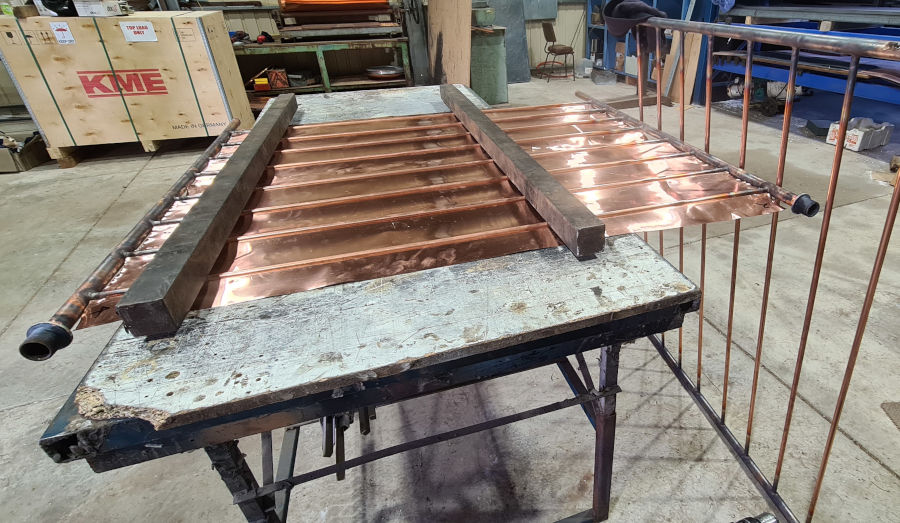
Beasley are long gone, but so well regarded people still want them. Here we see the guts of a traditional flat plate solar thermal collector. 25mm manifolds with 13mm risers and sheet copper to absorb heat and transfer it to the risers. Bill from Gramall is making these as I write.
Thermosiphon Circulation – Just Add Heat
The elegant simplicity of these flat plate systems, (and of the later Solahart close coupled units that came from Western Australia) is that they require no pump. Whether it’s a wood stove or a solar thermal collector, heat rises, and that’s what circulates the water in the tank.
The major downfall of solar thermal hot water, if there is one, is also simple physics. When temperatures fall, freezing water can tear a collector apart. There are solutions, like jackets full of antifreeze, expansion valves and elements, but probably the most novel was an all-plastic hot water service, the (not quite) Genius from the sadly defunct Solco. Most failed under warranty, the rest will last forever.
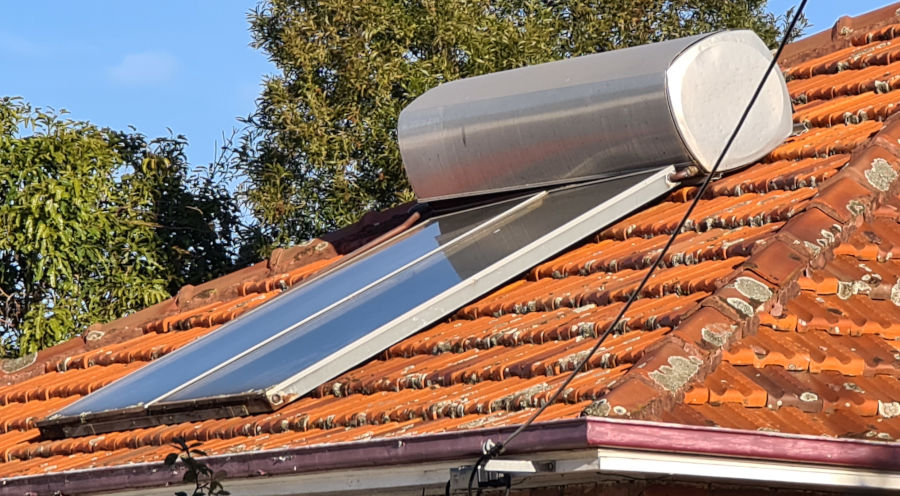
This Solahart would date to around 1978-82, and it’s one of three I know of that vintage still on roofs in Adelaide.
Aren’t We Using Heat Pumps Instead Of Burning Stumps?
Heat pumps are incredibly good at making hot water from a few measly watts of electricity, but heat pumps are complex. A standard heating element is still a perfectly clean way to make water hot if you have lots of surplus solar power.
Using a smaller-than-usual element in combination with a relay controlled by your solar inverter (or an even more precise solar diverter such as a Catchpower Greencatch) means you can still utilise sunshine very effectively, without the complexity of frost protection.
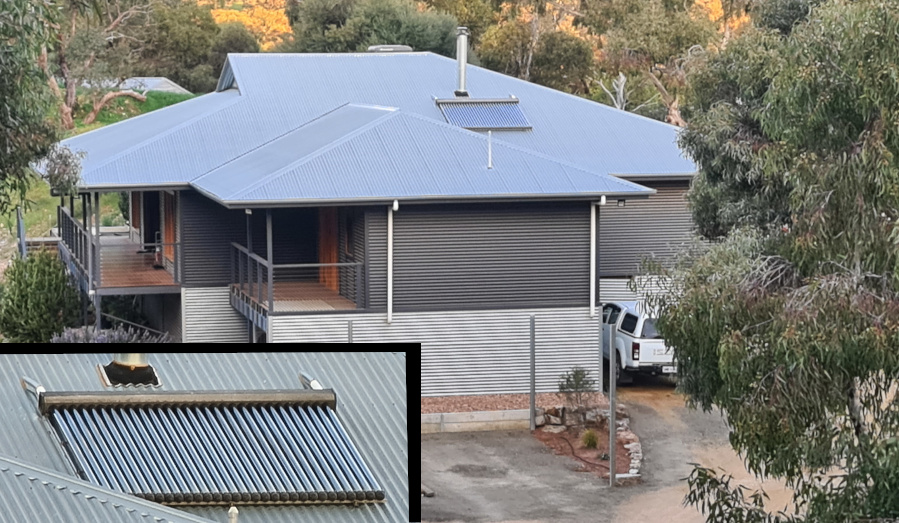
Despite planning to hook up a wood-fired stove, this array of 30 evacuated glass tubes proved so effective it wasn’t needed, plus there are no issues with frost – sometimes a problem in the Barossa Valley.
What Do I Recommend For My Own Mum, Uncle, Best Mates?
There is no one-size-fits-all solution, but the house pictured above was designed with this hot water system from the outset. Sadly, not everyone’s house is suited, but we have reinstated tanks in the ceiling space in a couple of cases because modern solutions were proven wanting. For example, an instant gas unit isn’t compliant when installed next to a window or door.
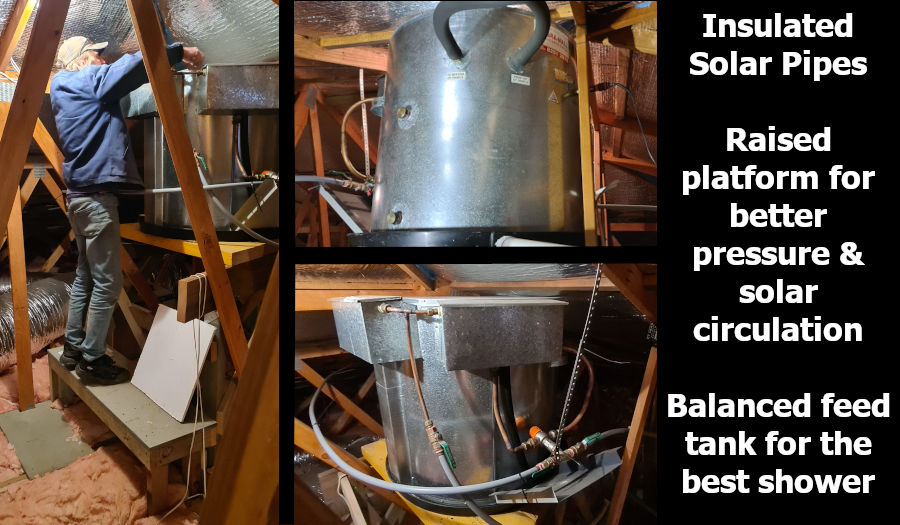
A thing of beauty, complete with attic lighting and step-up for easy service.
Why I Love Copper-Bottomed Hot Water
In no particular order, I’d like to point out;
- Copper hot water tanks are lightweight compared to steel and don’t need the vast manufacturing heat used for glass lining.
- Copper is easily recycled and valuable enough that people ensure it doesn’t get thrown away.
- Placed in the roof space, a tank can be in the middle of your house, reducing draw-off and time wasted waiting for hot water [1 Running hot water to the kitchen of my current house wastes 3 litres of water and the energy to heat it].
- Being inside the house’s envelope is more efficient as you have less standing losses.
- Using the roof keeps your outdoor area neater and saves space, especially precious if you need a wall to hang a home battery on.
- The only wiring is for a perfectly simple thermostat and element.
- Diagnosis and repairs are easy for any plumber or electrician.
It’s As Much About What Isn’t There
- There’s no hot pressure relief valve to leak, replace or blow off 300 litres of water in summer overheating.
- There’s no sacrificial anode to replace. In fact, the only service part is a simple ballcock.
- There are no pumps, sensors or controllers.
- There’s no chance of a gas explosion
- There’s no chance of a BLEV tank explosion.
An exploding water heater can shoot up about 500 feet (150 m) in the air at around 300 miles per hour
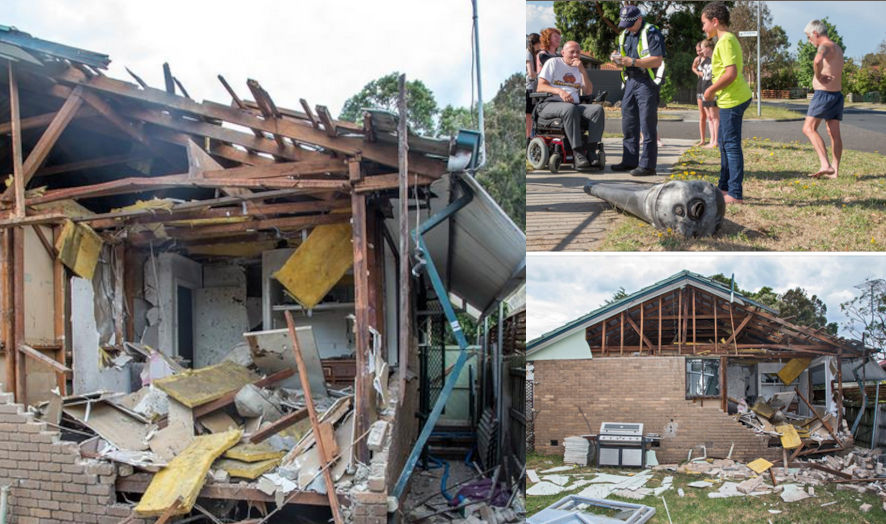
Obviously, this is an outlier, but many people don’t realise that flammable gas isn’t needed, steam alone is enough to demolish a house and launch a tank 200 metres away.
What About The Pressure?
People complain about weak showers from poorly plumbed gravity feed systems, but the excess consumption created by mains pressure means, ironically, we now have laws mandating restrictive plumbing to conserve water, and that demands mains pressure.
When my Mum’s house had to be fitted out for an accessible bathroom, regulations insisted they use modern tapware. Any flickmixer or ¼ turn tap using ceramic inserts will flow very little water if you only have gravity feed. Some hot water units are replaced for this reason alone. Luckily, there is an answer that makes for the most durable hot water service ever.
By installing a 36 metre length of 19mm copper pipe as a heat exchange coil, you can combine the low pressure, low stress durability of traditional copper hot water with the modern need for high pressure delivery.
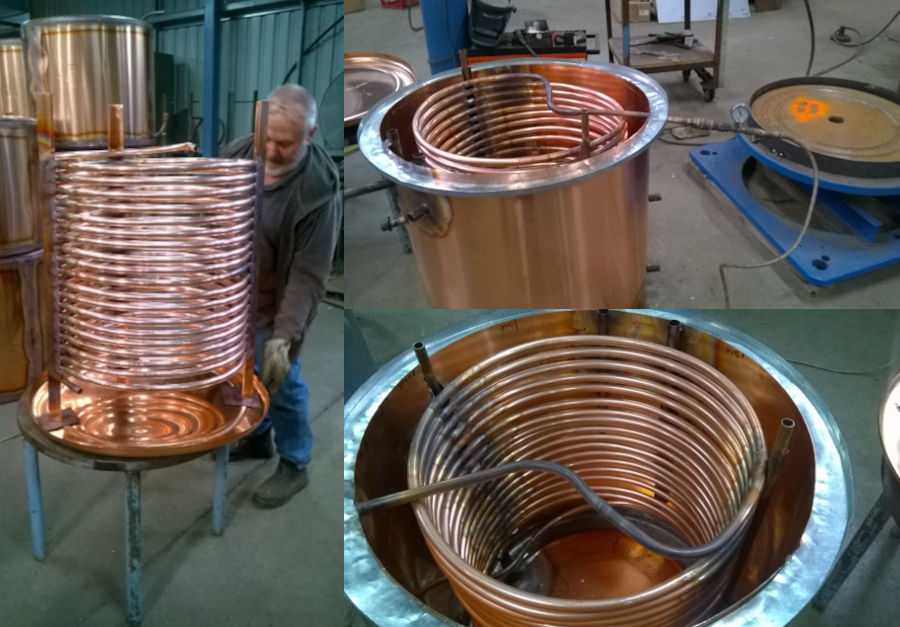
Coiled heat exchanger. A design grand enough that even Kevin Mcleod would be impressed.
Bespoke Beauty
The beauty of a system like this is that it’s flexible. They’re common in Europe and you can choose a variety of methods to heat the thermal mass in the tank:
- solar thermal
- resistive via solar PV
- wood burner
- heat pump unit
Add antifreeze or anti-corrosive solution, plumb it off to heat a towel rail or radiator too, while the potable water simply travels through a perfectly safe and reliable length of pipe.
A standard gravity-fed unit is pretty cheap, but adding heat exchange coils, solar panels and stove fittings, and balanced feed tanks means you’re looking at a few weeks lead time for a custom-built unit. Of course, all these peripheral accessories can add expense too, but if you already have them, it’s a shame to render them useless because your plumber is too lazy to do a decent job.
Hot Water In The Ceiling Is Still An Option
Many plumbers have websites claiming ceiling units are redundant. It’s bullshit.
Be aware you’ll often get advice about what’s profitable for the plumber disguised as what’s good for you. In truth, it’s just cheap and easy to wheel in with a standard tank or an instant gas unit, hook up a few pipes outside and crimp off the old ones in the roof. Pipes seldom get shortened to suit, and in some horror cases the electricity is left connected and the empty tank gets heated for absolutely nothing. True story.
Solar Powered Copper Bottomed Hot Water
Our old Beasley solar thermal unit ran for free 8+ months of the year, but when the roof sheets rusted out, I installed 38kW of PV solar for my Mum. We ran out of roof space for a thermal collector, so we just crush the consumption with electrical sunshine now.
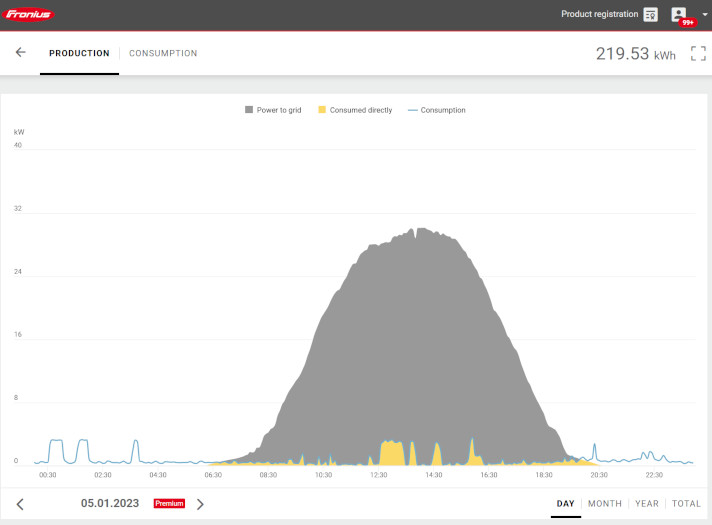
Those little yellow blips are a full-sized 3.6kW hot water element being crushed under a mountain of solar.
Copper hot water isn’t the standard any more, modern truss-built houses aren’t designed for them, and many young buck plumbers simply won’t have experience with handling or opening the roof to change one out1.
If your house had one of these beauties to begin with, there’s a good chance you can reinstate it easily enough, and even power it with surplus solar energy.
In the process, you’ll have supported some grassroots Australian manufacturing and saved all the energy involved in manufacturing, shipping and installing a modern consumer hot water unit.
Footnotes
- Floor-standing units are available ↩

 RSS - Posts
RSS - Posts



Good lunchtime quick read Anthony
Hmm, I discovered a while back our house still has one of these in the roof space, capped off years ago and not used.
Worth somewhere around $60-$100 in copper if you want to get it out
Interesting article thanks. I love the simplicity of an all copper system!
We had a mains powered heat exchange copper system in our 1960s era first house- was ok but pressure and hot water delivery wasn’t great.
When we bought our next house in 1995, (built in the mid ‘70s) the traditional mains pressure glass lined steel HWS was dead- with a slow leak. With four young boys, I bit the bullet and replumbed and installed an Edwards SS system on the roof, which has been fabulous. Funny- the plumber didn’t want to install a tempering valve, said it would only last a year or two, but I absolutely insisted for very obvious reasons. (It would have been absolutely lethal here in summer without!)
And yes, I replaced the tempering valve just ONCE in about 2010.
Sadly last year the whole system died a slow death, (that’s just over 27 years later) with rust in the outer case and a small leak on one of the collector’s connections.
So long story short, decided to replace it with a similar system from a different manufacturer, and just hope it will last as well as the Edwards did- though that may be wishful thinking.
With only my wife and I living here now, we have not boosted it since day one, even when grandchildren stay. I actually checked the element was working, but have left it turned off and never needed to boost, even after days of overcast here in SEQ.
I don’t know what I’ll do if the current new system ever fails. Part of the problem is anything else would need major replumbing, just adding to the cost. Going for a copper tank in the ceiling would be problematic due to availability of space.
Your article has made us rethink, we have an on outside of roof solar with anti freeze. It has a stainless steel tank with anode for boost heating. Sadly the aluminium solar collectors have lost their black coating. Some years ago took off very thin glass on one collector of the two and painted with flat black collector plate, carefully siliconed glass back on. This improved solar collection, but still not great.
Have a lot of solar power 11.5kW and 10kW battery so despite loss of efficiency we still have hot water. The Edwards solar hot water system has lasted so far 23yrs and we have been thinking we got our money’s worth and should replace, even though it still works but nor as efficiently as it requires more electric boosting than it use to, we were thinking about heat pumps, but your article has prompted a rethink.
Can you recommend any brands that are well made and could be a direct replacement for an area that gets lots of frosts at 800m and East of Queanbeyan NSW.
Terry,
as I said later in this dialogue, you can replace the collectors only. I bought some good s/h ones (different manufacturer, but no problem fitting). One thing to watch is to carefully deburr the thermosiphon lines when you graft them to the original lines. You do not want any restriction or turbulence from the joints. All the seals are still available, & should be changed. You could also graft on a Heat tube collector: just make sure there is a difference in height inlet to outlet on the collector (ie angle the collector slightly). I think the Edwards tank is superior to many made now. Another tip is to use a large radius bend at the collector instead of a brass elbow to improve flow.
I had to replace a 300 litre electric hot water unit recently. What a horrible experience. Every company I spoke to tried to force a $3,000+ heat pump unit on me, despite a 15-20 year payback period.
Then there was the install fees. The cheapest was $500, then $1,000, $1,100 and $1,500. This for the simplest outdoor install. The company that I chose sent two very young guys who took less than 45 mins to do the entire job. Had I chosen the most expensive quote of $1,500 that’s around $1,000 per hour EACH. Is this really what we’re paying now???
Sounds like an interesting option! Unfortunately it wouldn’t work in our house because of our horribly tiny ceiling cavity (just ask the electrician that had to install a powerpoint for us. He had to get on top of the double story roof and take a few tiles off as he couldn’t fit under the cross beam!)
I’m not a fan of heat pump units. They seem to be pretty unreliable & a little noisy from what I’ve read and they are quite expensive (circa $3k plus installation).
We had to replace our hot water system due to us getting rid of gas as it was our only remaining gas appliance after our kitchen renovation and we just went with an old fashioned 80L resistive hot water system. It cost $700 plus installation. The thing I love about them is that because the water is so hot, it makes sense to get a much smaller system than you’d think it needs. 80L sounds like nothing, but it lasts longer than our 170L gas storage system did.
I always sing the praises of thermosyphon solar hot water
Our 3 x flat plate collectors keep our 320ltr tank hot for 9 Months of the year with no boosting. I have 1kW of off grid solar and a little inverter added and a dual supply switch.Some years we have no grid boosting at all. (Adelaide) 39.1kW this Winter. As we are still on the PFiT I would rather not use our solar for water heating.
I’m not sure if that is the same guy but I have bought my last 2 from a place on Golden Grove Rd. The previous one developed a leak from the drain pipe. A design flaw me thinks but we still got a longish life from it.
I sent a photo and other details to the company and a week later had an exact copy and the name of a plumber who might install it. By the amount of swearing, I’m guessing he didn’t have a lot of fun in our relatively tight roofspace.
I think I was lucky that both gentlemen are still working but have the feeling both are looking to retire. It would be a great shame if this solution is no longer available for water heating
I thought i had gone back in time. surely nobody uses these systems any more
We do and have for 40 years and would not use anything else given the chance.
Unfortunately they are getting harder to source. Not sure about the flat plate collectors. Got my last collector from Rinnai for about $700 As they are low pressure they should have a long life too
I agree with the your comment on the durability of copper. We have had our present house for 27 years and the HW system was not new when we moved in so 30 to 40 years old. A new thermostat (less than $30) about 10 years ago.
It seems that many heat pump HW systems give problems which is surprising because they should be as reliable as refrigerators.
Hi – you state in one of your picture captions…
“Despite planning to hook up a wood-fired stove, this array of 30 evacuated glass tubes proved so effective it wasn’t needed, plus there are no issues with frost – sometimes a problem in the Barossa Valley.”
but, for some reason, evacuated tube collectors hardly seem to rate a mention! Why??
It maketh no sense.
We have one (RunOnSun) – stainless steel roof mounted tank – and bugger -all water pressure – (and yes, we have a camping style gas heater as a booster for our continuing cloudy weather) – but when the sun comes out – there’s plenty of hot water!
If a tube breaks – there is no release of water.
Interestingly a lot of the development and research on evacuated tube SHWS was done by Sydney Uni in the 70’s.
Plus – they can’t suffer from the “whitening bug” – a fungus, that in so many systems obscures the glass of the flat plate collector with a white film, and stops them working (the fungus is a chemo-troph and feeds on the compounds released from the polystyrene insulation used in older systems, which breaks down in the humidity and heat)
I’ve just purchased an evacuated tube split system kit from Run-On-Sun.
Whilst the efficiency of close coupled solar hot way water systems is excellent, the controllability is not. Boiling water is a problem. Further, an exposed tank on roof will be subject to greater standing losses in winter, and the horizontal rather than vertical tank is suboptimal in relation to total hot water availability (stratification benefit. And then there’s increased maintenance burden when the tank is less accessible and “out of sight, out of mind”.
My tank is going within a central alcove room in the mid point of our house in our upper storey…. and I’ve also designed in a roof access door from this alcove room also.
I live on a farm. Our water system is a 2000L hyeader tank on a 7.5M tank stand. We use ceramic flick taps with no problem. 10M height gives abt 15psi. You need more than about 7.5 psi to turn on some washing machine solenoids (but not all!)
The advantage of low pressure is much less water use. We have 7 people using our water & the tank is filled less than weekly. (The toilets use other water tho).
I have a 25 y o stainless (Solar Edwards) HWS. These work well on low pressure (they can fatigue around fittings if on high pressure, particularly where they have a non-return valve & a sticky pressure release valve). It was actually moved to install a new roof under it about 8 years ago: replaced the solar collectors, but re-used tank.
Some of the Asian sourced Heat Tube HWS are LP stainless tank & copper heat exchanger. These are great as a pre-heater for solar PV powered HWS mounted close to usage points. Hot water in, little water loss & solar PV keeping the heat topped up: best of all worlds, & the Solar HWS can be a long way from the small HWS connected to the taps. Great for environmental conscience, or running off rain water tank.
Copper systems are fine too. If the Element has failed & a replacement cannot be sourced, Istra Elements in Caringbah, NSW can make an element, even low voltage or low wattage to suit PV.
Hi What do you mean by Heat Tube HWS? I’m surprised that there seems to be a cultural blind spot when it come to Evacuated Tube HWS! – they are definitely the “No Mess, No Fuss” technology! (and they work a treat even in sub zero weather – (so long as there is sunshine then). Maybe Anthony might be persuaded to do an article on them!
Yes Hugh,
Evacuated glass tubes are a marvel and that’s why I’ve got a picture of old mate and his galvanised roof, that was a new house designed from the outset to have them and they work brilliantly.
Great article. Thank you.
My mum still has her 55 year old hot water tank in the ceiling, attached to solar hot water panels.
Very, very long lived.
I used to sell and install Thermomax evacuated solar hot water tubes in 1979 till 1989. They were imported from Europe and distributed by the importer from Orange NSW. Evacuated solar heat tubes have been around a lot longer than people think.
Great reading, I grew up on farm with wood stove and hot water jacket, HWS sat above woodbox with internal door in kitchen beside stove, kettles allways simmering, great memories. Dont really miss the wood gathering though.
GAMMAL Link takes me to ASIC ??
Yes Handy,
The ASIC site shows Grammal have been making hot water since 1976… there’s a street address but they don’t have a website.
Best to ring Bill and talk to him.
Great piece of informative writing Anthony, as always with your articles.
We have a 30 year old Beasley hw tank in the roof cavity, it’s fed by a pressure pump taking water from a rainwater tank.
Gravity fed and majority of piping in roof and wall space to usual places.
Currently, hw water boils over every night – 3/4 or so of a bucket – can find nowhere to adjust anything thermostatically… maybe a sacrificial anode in need of replacement ? … not a point of informed speculation by me.
About to have a smart meter installed, after which I want to look to the SQ 3 quotes on solar – panels/hw/grid interchange/no battery yet, sort of things.
Question is, given the retro set up for our hw, can I expect those offering quotes to necessarily be across and creative with what they’ll meet in the roof space?
I’d be on to go resistive with copper emphasis hw wise… Do I really need to have someone with nous and experience check things out prior to asking for
quotations, or would those quoting have ready recourse to experience that would suffice on the day ?
If time permits and you could offer some direction/advice, that’d be very helpful right now. Sorry this is more a laboured question than a comment.
Thanks,
Adrian Kitchener
John T
I know this post is a bit old, but we have a 40 year+ Beasley in our place (we put it in during the build) that I have set up with waste woodfire flue heat, and evac tubes…both working via convection. Little elec boost needed, as if the day is cold the fire is generally running harder and perhaps 24/7. I’ve measured it running moderate fire at a little under 1Kw, but does need regular cleaning, so your fireplace needs to make this easy with removable baffle plates.
I’m a mech services plumber, so setting this all up was fairly simple for me, but was innately complex given locations needed.
If the Beasley is genuine, and if the unit is truly “boiling” then the stat is stuck closed. But I’m more thinking that you need to adjust the ball valve, or renew the valve rubber. If the inbuilt header tank is keeping the level very close to the innate overflow level, standard element heating will make it spill.
Take the lid off the header box, adjust arm to suit for lower level; or for rubber change…..pull the pin on the float arm, lower it out of the “socket” and the valve piston can be pulled out. (Of course turn off the water inlet first!) The rubber is easily changed with spares from your local hardware. Worn rubbers generally increase the water level, but sometimes the opposite happens. Good luck.
Evacuated Tube solar hot water systems are excellent, can easily boil our 250L storage tank on long sunny summer days.. i have remote temp sensing probe in the tank, and when approaching 95’C will pump/dump the excess heat into my spa water to get it warmed up..
It also has an element built in for cloudy winter days, but at the moment we still have gas connected, and an old instant gas unit that provides help over winter period.
Edson Global Solutions – 1300 880 154 – [email protected] – I have read your article with interest. Edson used to manufacture Hot Water Systems using Copper. Still, we have replaced Copper with Stainless Steel – unfortunately, the cost of Copper is expensive, and finding skilled labor that can work with Copper is also proving difficult – unless it is about building Stills for making Gin, etc. Edson still manufactures Ceiling Mounted Gravity Fed Hot Water System that operates using the principles of thermosyphon. We also provide Ground Mounted Solutions that can work through the use of Thermosyphon – we also do ‘pumped’ solutions. We also offer Heat Pump solutions that can be used as an alternative to Electric Elements in Mounted Systems. All of these solutions can be coupled with an Edson Power Diverter. Stainless Steel is made from recycled metals. We use a Sacrificial Anode due to the variability of regional water sources. Our tanks are fitted standard with a Stainless Steel Internal Coil—we regularly coupe our tanks together with Wood Heaters, Wood Stoves, etc. Our tanks are supplied standard with Solar Connections, Stove Connections, Feed Tanks, Safe Trays, Electric Element etc. INCEILING UNITS ARE NOT REDUNDANT!! We provide replacement units for Beasley systems and have quoted them as late as today.
I was all set on getting a heat pump until I read this. It seems intriguing but I as an average homeowner I don’t know where to start. Does anybody have any pointers so that I learn more without being sold to?
It really depends on the particular circumstances of your home as to what would be most suitable…. specifically your roof design / orientation, and where you are located.
If you’re in one of the more sunny areas of the country (ie – not Melbourne), and your roof design is sympathetic to the installation of an evacuated tube solar hot water array… then you can pretty much guarantee that a top quality split system (tank on ground) evacuated tube solar hot water array, with mid-mounted element for electric backup for the tank, will outperform the top quality heat pump hot water systems (Reclaim, Sanden, Thermann X Split). Further, if the solar hot water heating system is installed well, it will out last the heat pump system.
For out Adelaide Hills home, I bought an evacuated tube array (30 tube) system from Run On Sun Australia complete with 315 litre tank and a heap of other bits and pieces for the installation for $5325 incl GST and freight to Adelaide. The base system supply price is $3990 (I bought a few extra goodies). I’ll be setting up most of the installation myself and leaving final connections to the plumber. Once the system is fully commissioned, I’ll be able to claim the STC rebates.
The top installation considerations for installation of a solar hot water system:
1) A section of largely un-shaded NORTH FACING roof (that won’t unduly impede options for rooftop solar PV)
2) Ability to install on a tilt frame to optimise winter heat gain (in my case for Adelaide – that means a nominal 58.5°… I’ve got a 45° tilt frame on my 15° pitch roof to give me an overall 60° tilt angle
If this all lines up as an option for you, give Andrew Butterworth a call at Run On Sun Australia.
Or.. don’t, unless you like throwing away money for absolutely no reason. For an average family, the payback time for that system would significantly exceed its warranty period, and perhaps its useful lifetime. Even if you spend excessive amounts on hot water, you’re still paying for 10 to 15 years of hot water *in advance*. WHY???
Hi LPTF –
I disagree. But that’s OK, there’s no problems with people having different opinions and ways of analysing things.
What’s your thoughts then on the best hot water system to spend your money on?
Has anybody with a conventional 3.6 kW hot water tank and a 10 kW pv on the roof , thought about getting a sparky to change the controlled load to normal use with a timer set for maximum sola panel generation around midday?
I’m paying 23 cents/ kWh for controlled load, which is on another meter, separate to feed in which is only 8 cents/kWh. I’m in Adelaide and also have a powerwall.
I’m aware that solahart have a smart hw system that senses when there is any excess solar energy to heat the water instead of feeding the excess into the grid for a miserable 8 cents. Has anyone got experience with one of these?